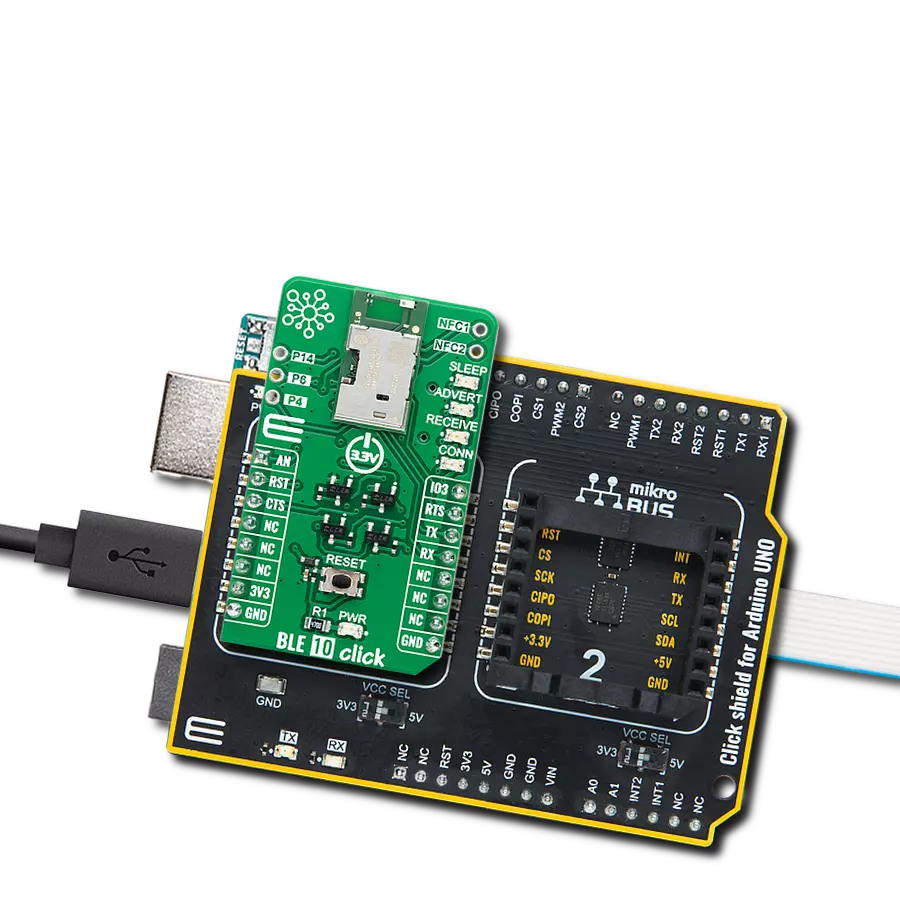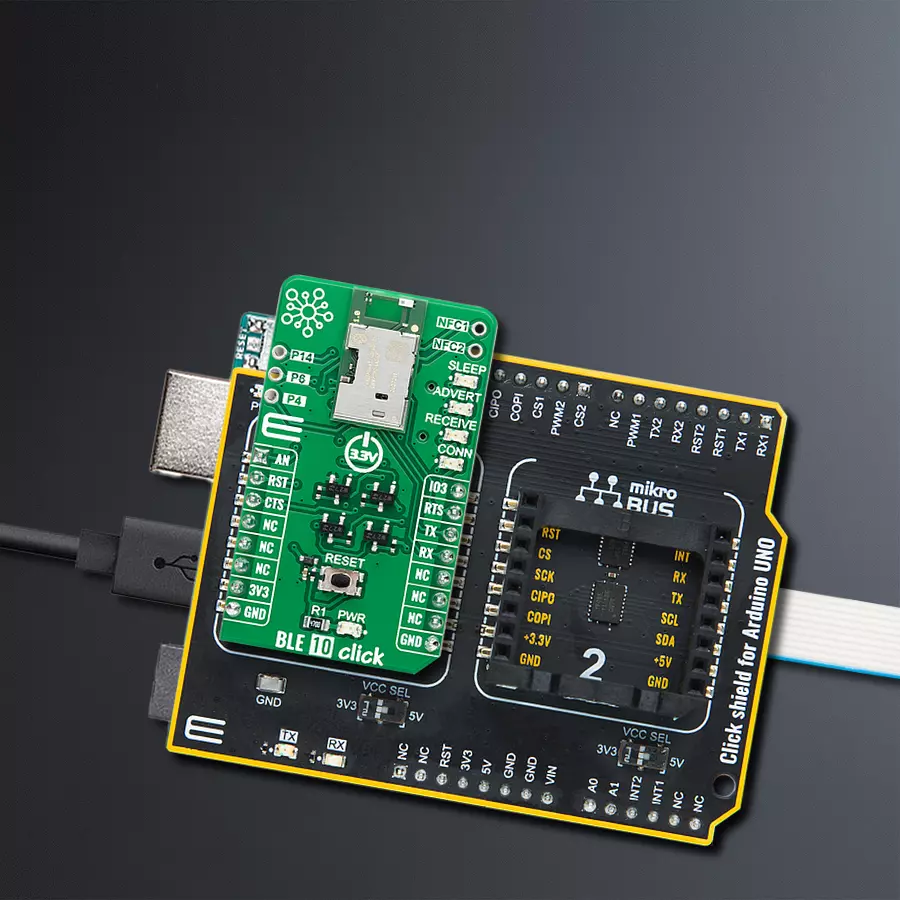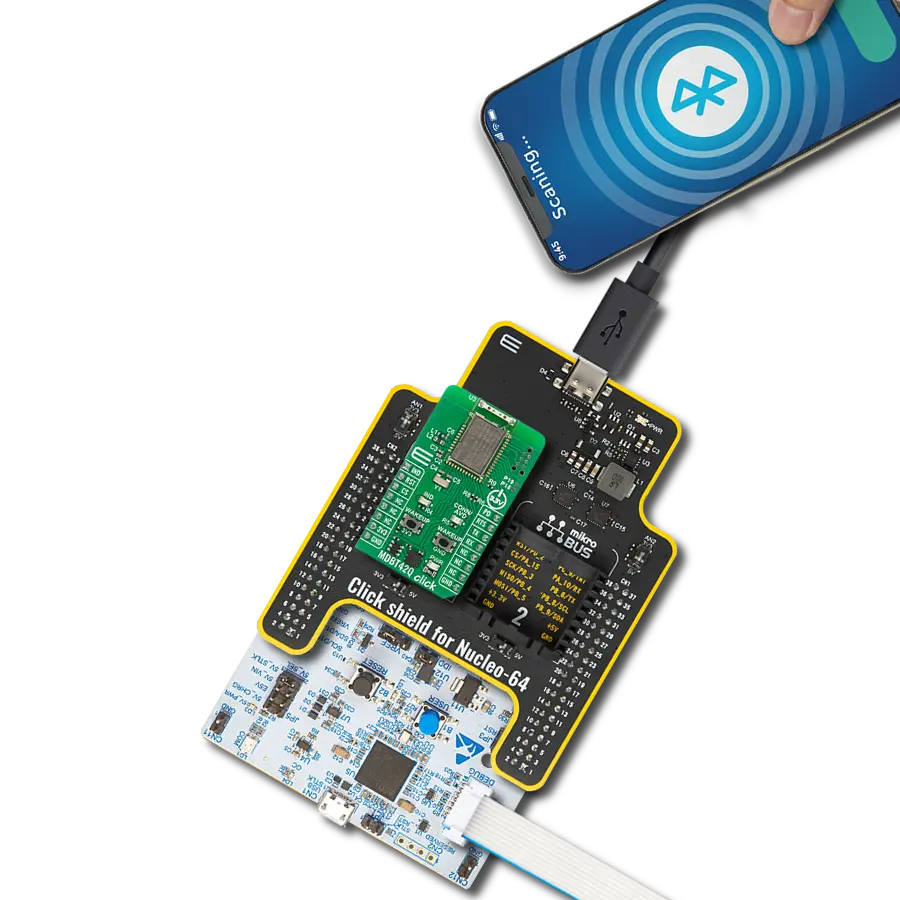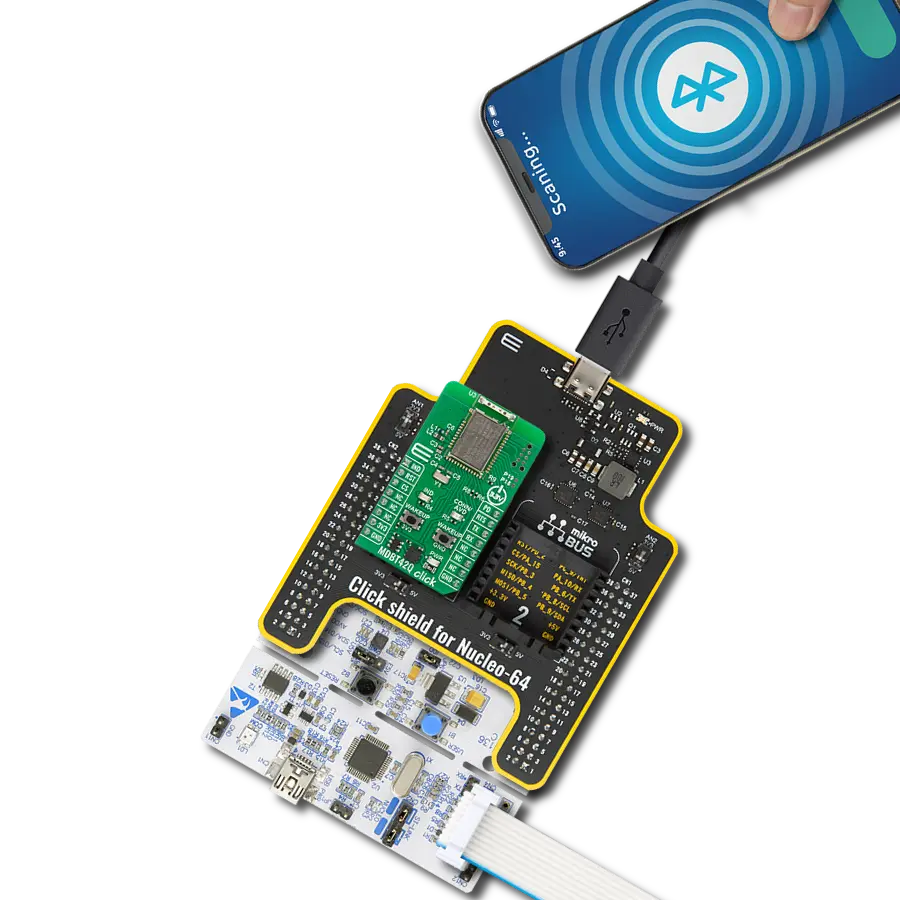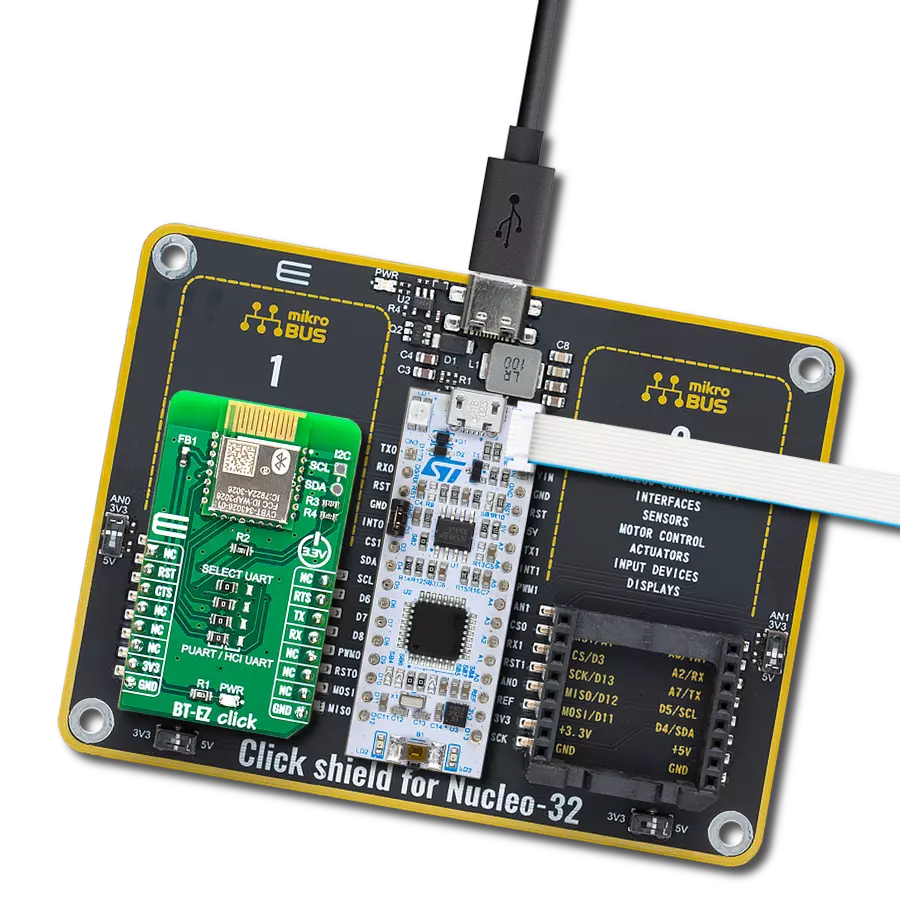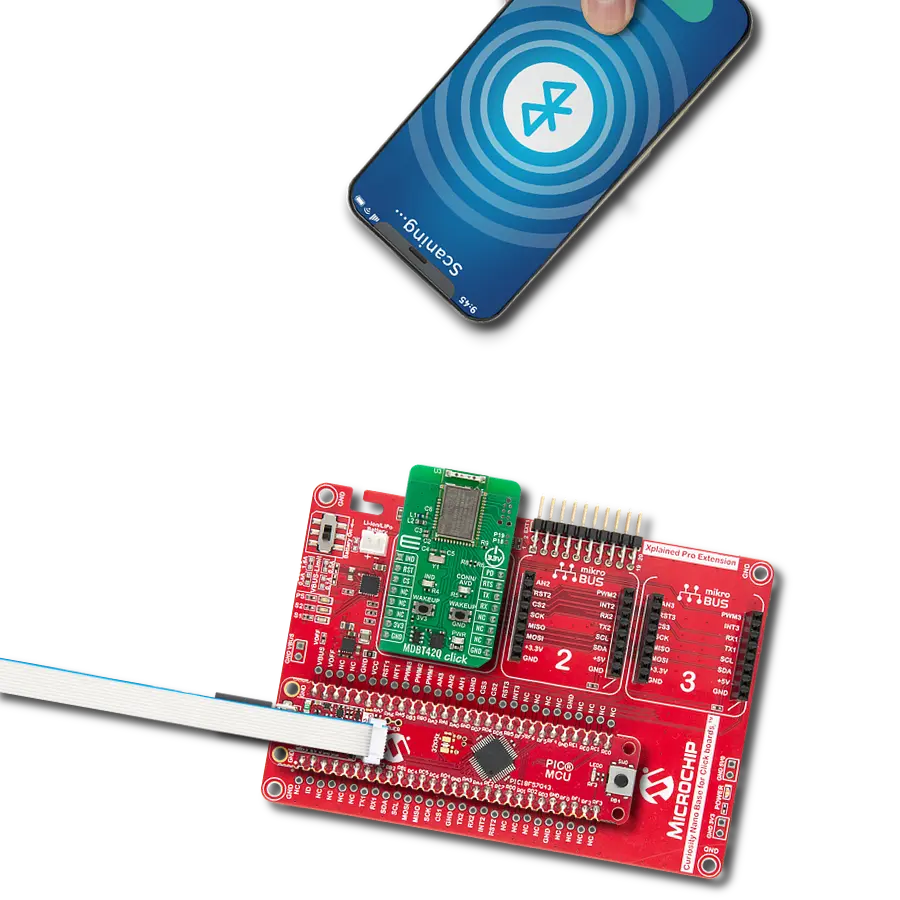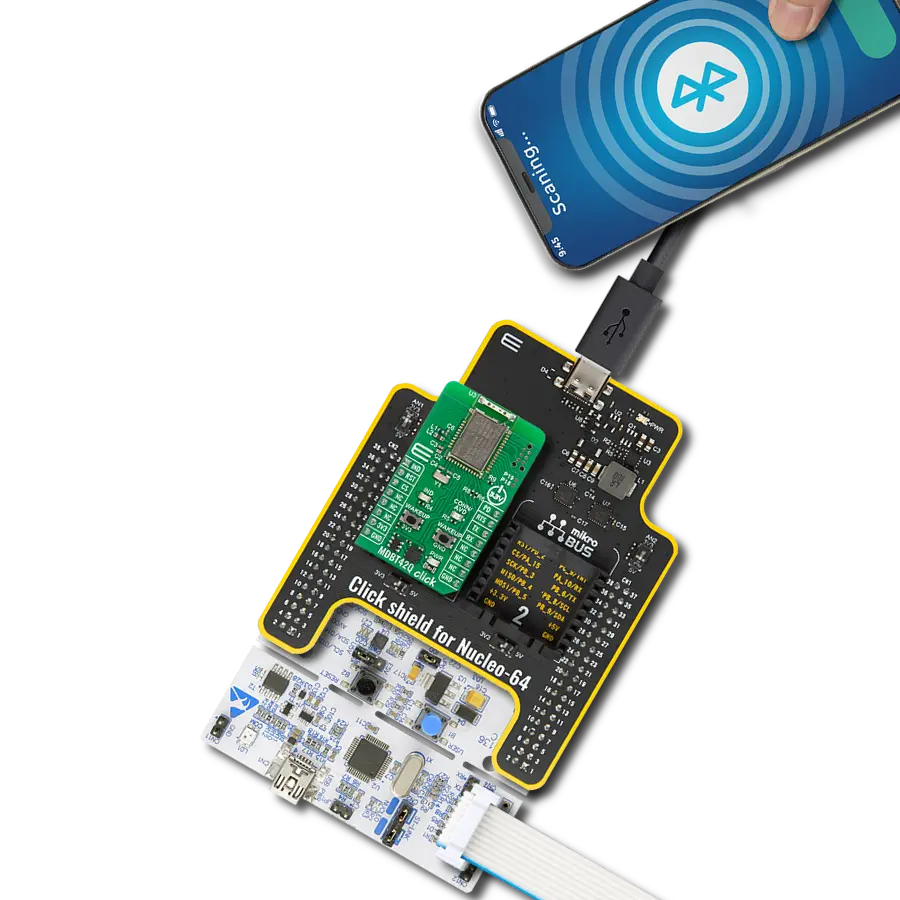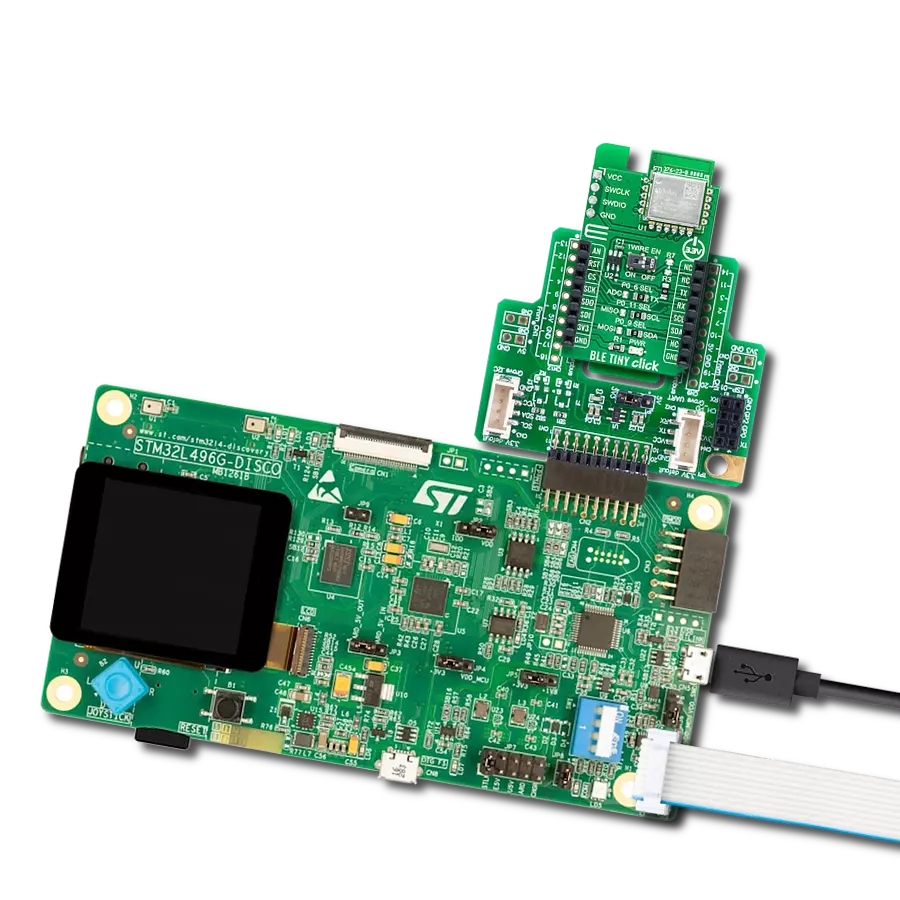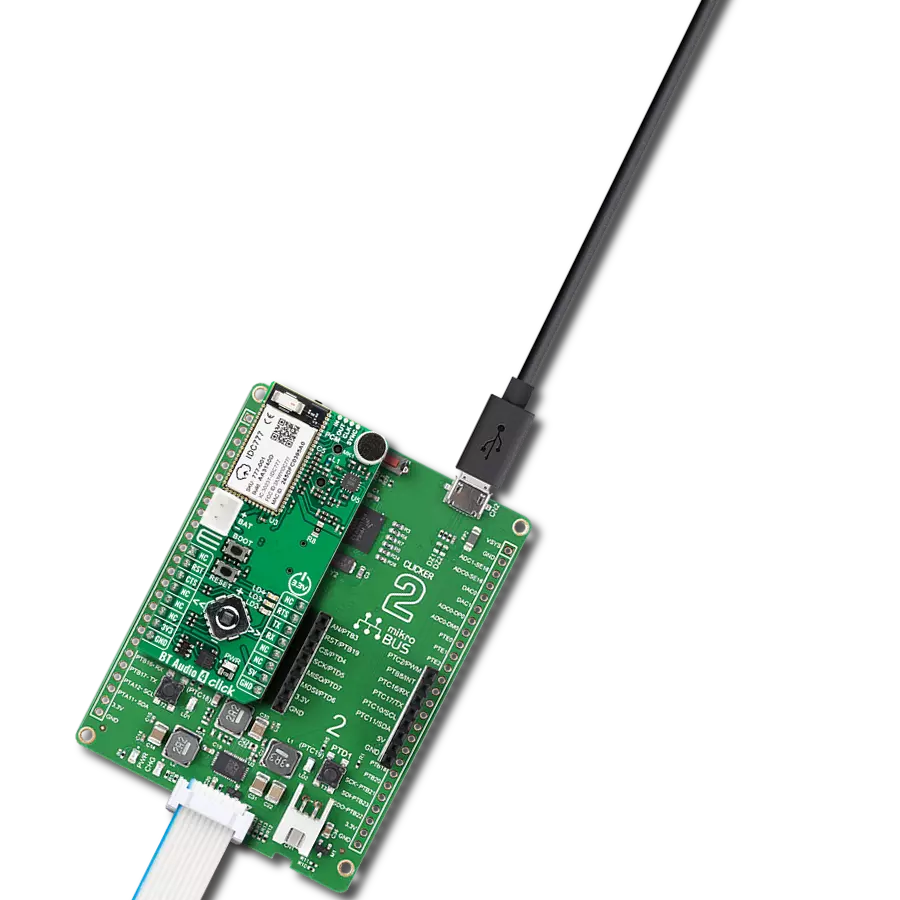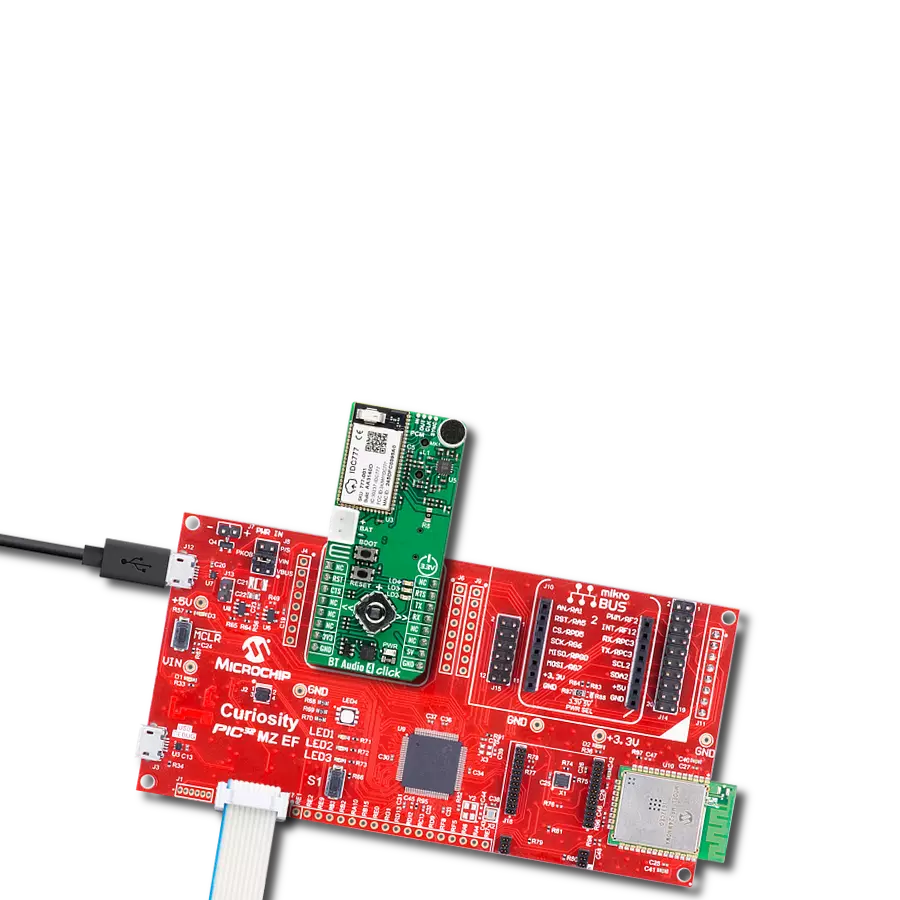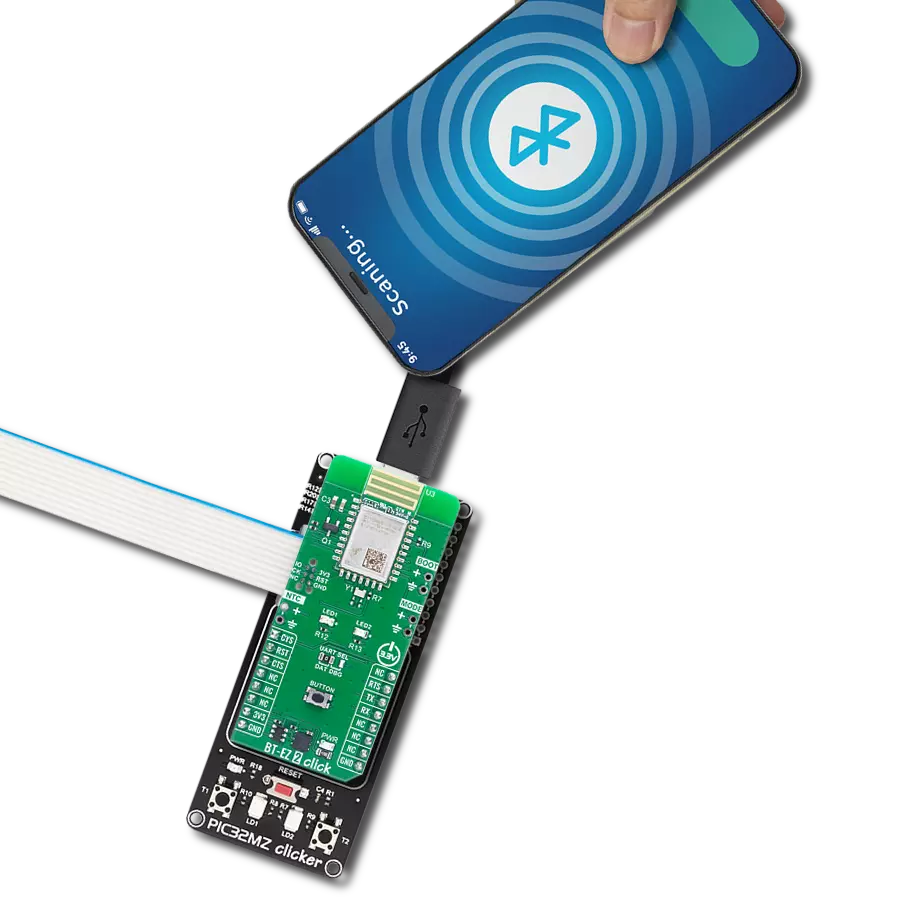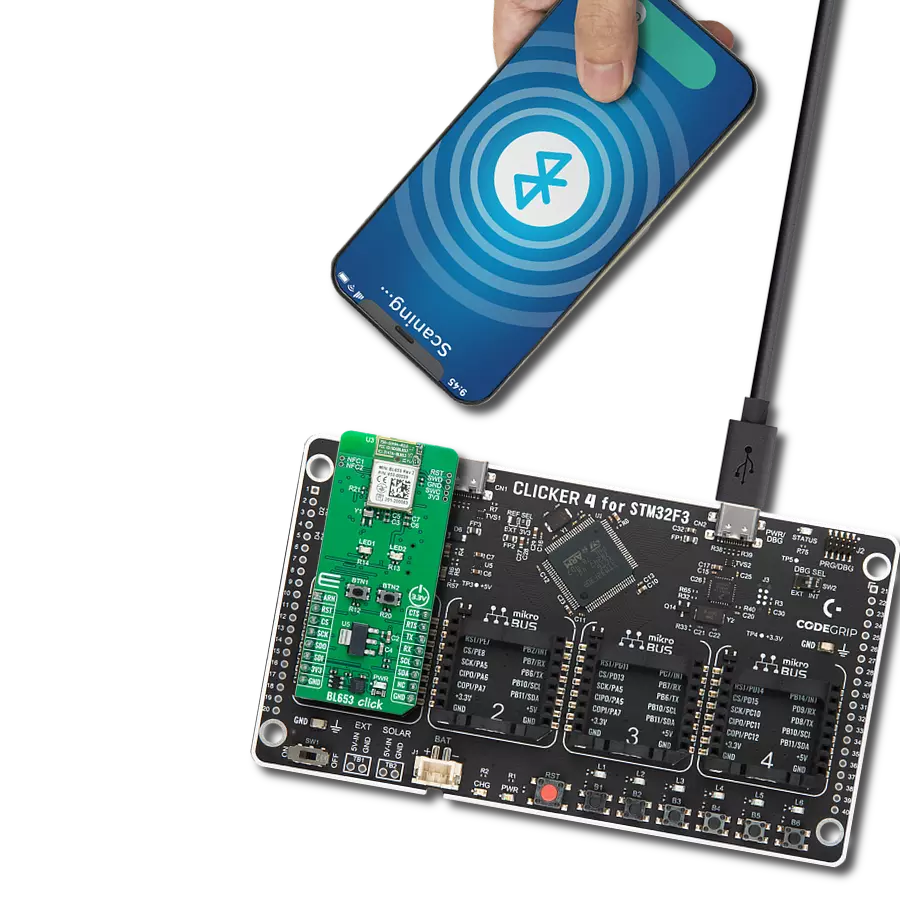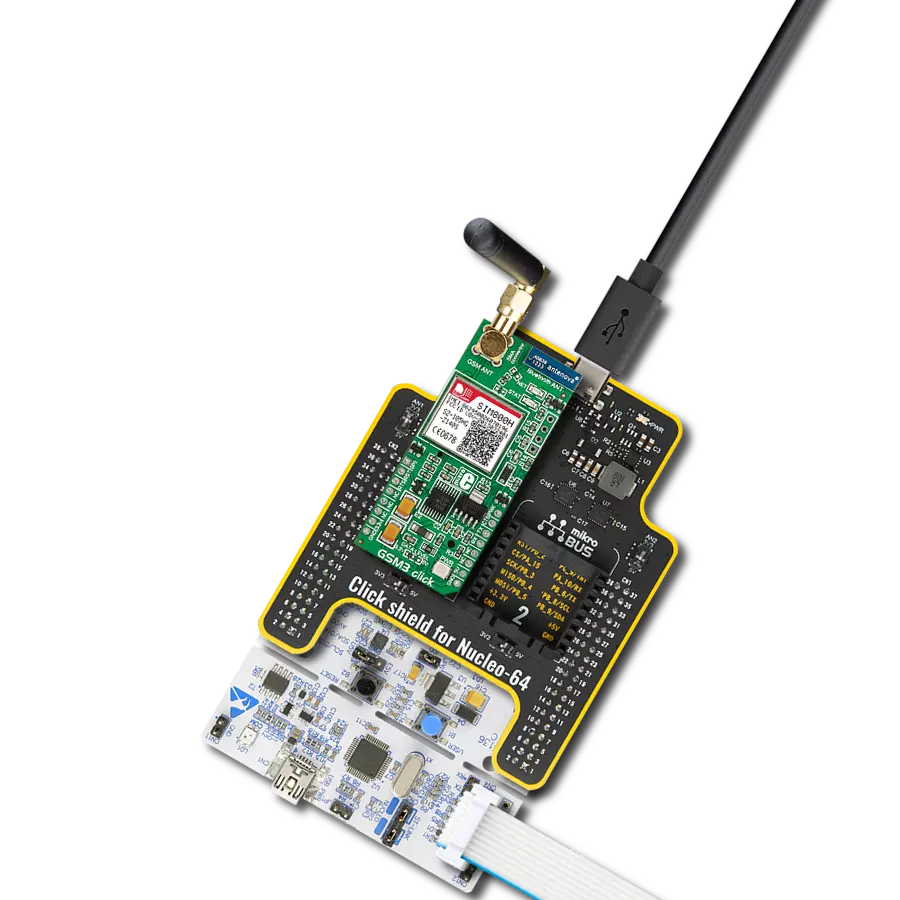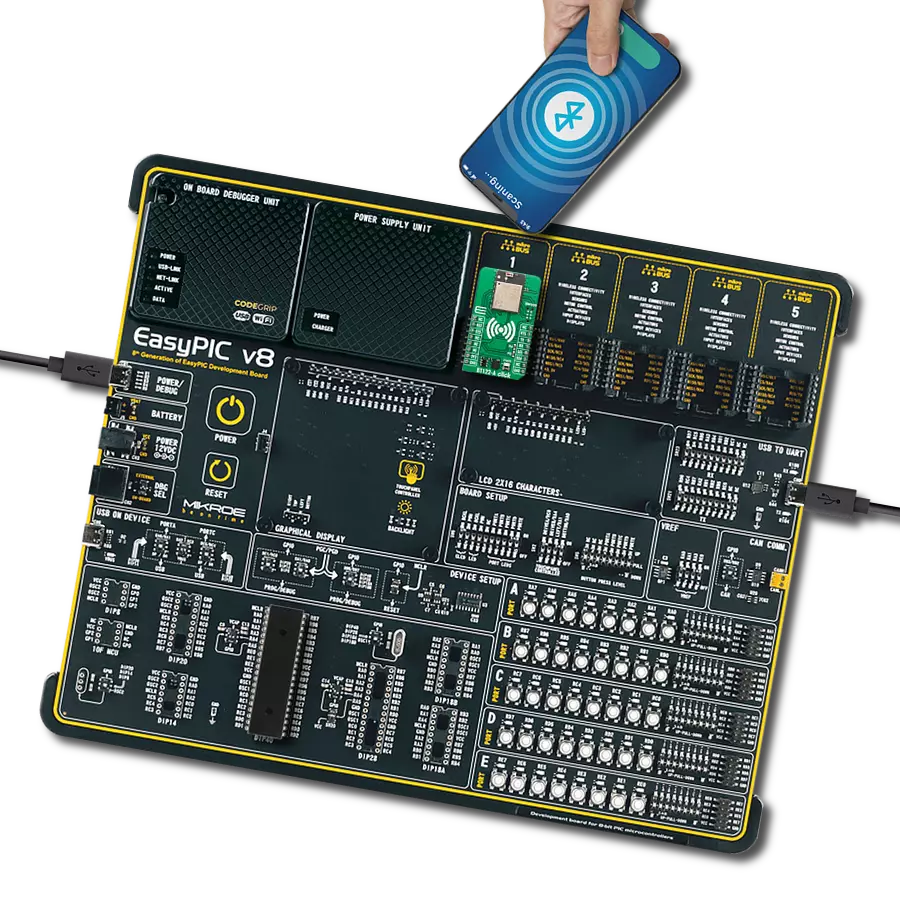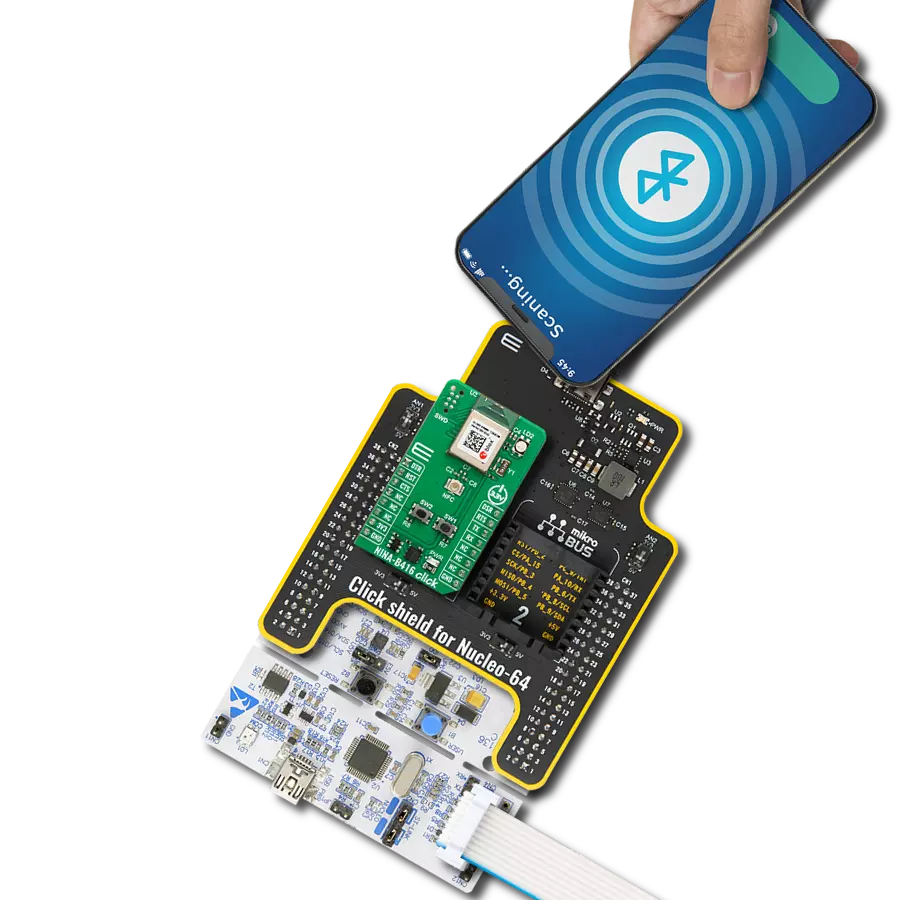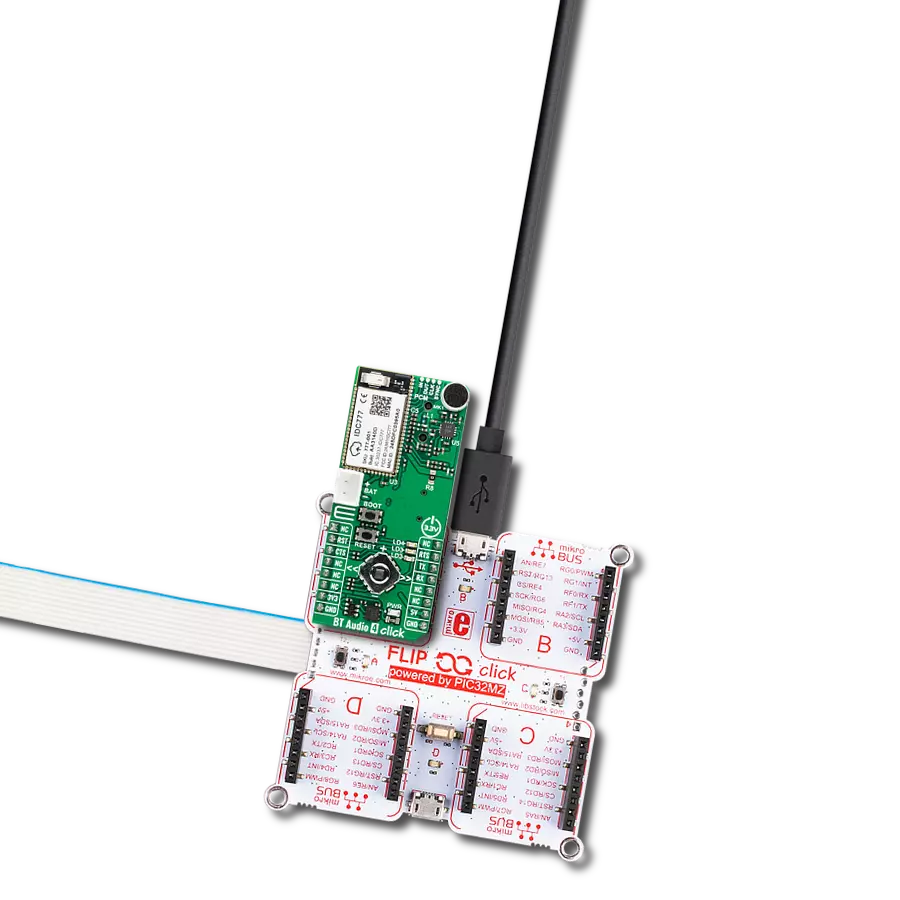从无缝音频流媒体到轻松数据传输,我们多功能的蓝牙解决方案是您进入互联世界的门户,旨在提升您的日常生活。
A
A
硬件概览
它是如何工作的?
BLE 10 Click基于PAN1780-AT,这是一个低功耗蓝牙®模块,为任何嵌入式应用提供BLE连接,由松下提供。PAN1780-AT基于Nordic的nRF52840单芯片控制器,集成了BlueRadios的nBlue™ Bluetooth AT.s LE命令集。凭借其ARM® Cortex®-M4F、1MB Flash和256kb RAM,PAN1780-AT在设计灵活性方面表现出色,其新的信道选择算法在高干扰环境中提高了性能。Bluetooth® 5具有更高的符号速率,使用高速LE 2M PHY可达2Mbps,或者使用LE Coded PHY可显著延长范围。最高输出功率为8dBm,加上nRF52840的高灵敏度和LE Coded PHY,使该模块在长距离应用中非常有吸引力。PAN1780-AT使用UART接口与MCU通信,默认通信协议为交换AT命令的常用UART RX、TX和硬件流控制引脚UART CTS和RTS
(Clear to Send和Ready to Send)。默认配置下的操作速率为115200bps,用于与主机MCU传输和交换数据。PAN1780-AT使用由BlueRadios开发的专有GATT配置文件来流式传输数据,它不是官方的蓝牙®配置文件。BlueRadios串行端口实现简化了用户体验,允许用户以类似于官方蓝牙®串行端口配置文件(SPP)在BR/EDR设备上工作的方式传输数据。该Click板™还配备了一个USB Type-C连接器,允许模块通过个人计算机(PC)供电和配置。除了这些功能外,它还使用了几个其他mikroBUS™引脚。一个复位按钮连接到mikroBUS™插座上的RST引脚,将模块置于复位状态,而连接到mikroBUS™插座上的AN和IO3引脚则表示模拟信号监视和GPIO信号,可用作睡眠模式切换功能。此外,它还具有四个橙色LED指示灯,用于指示各种功
能,例如睡眠模式激活、广告、接收数据/命令和成功的模块连接。在该Click板™上还可以找到两个未焊接的排针,其中一个用于连接外部NFC天线(Type 2近场通信(NFC-A),用于简化配对和支付解决方案),而第二个排针则代表三个附加的GPIO引脚,携带一些附加功能,其描述可以在附带的datasheet中找到。该Click板™只能在3.3V逻辑电压水平下运行。考虑到该板还可以通过USB供电,使用额外的LDO,TLV1117实现所需的3.3V电压为模块供电。LDO和3V3 mikroBUS™电源轨通过MAX40200二极管提供保护,以防止任何不必要的反向电压。在使用不同逻辑电平的MCU之前,该板还必须进行适当的逻辑电压电平转换。此外,该Click板™配备了包含函数和示例代码的库,可作为进一步开发的参考。
功能概述
开发板
Arduino UNO 是围绕 ATmega328P 芯片构建的多功能微控制器板。它为各种项目提供了广泛的连接选项,具有 14 个数字输入/输出引脚,其中六个支持 PWM 输出,以及六个模拟输入。其核心组件包括一个 16MHz 的陶瓷谐振器、一个 USB 连接器、一个电
源插孔、一个 ICSP 头和一个复位按钮,提供了为板 子供电和编程所需的一切。UNO 可以通过 USB 连接到计算机,也可以通过 AC-to-DC 适配器或电池供电。作为第一个 USB Arduino 板,它成为 Arduino 平台的基准,"Uno" 符号化其作为系列首款产品的地
位。这个名称选择,意为意大利语中的 "一",是为了 纪念 Arduino Software(IDE)1.0 的推出。最初与 Arduino Software(IDE)版本1.0 同时推出,Uno 自此成为后续 Arduino 发布的基础模型,体现了该平台的演进。
微控制器概述
MCU卡片 / MCU
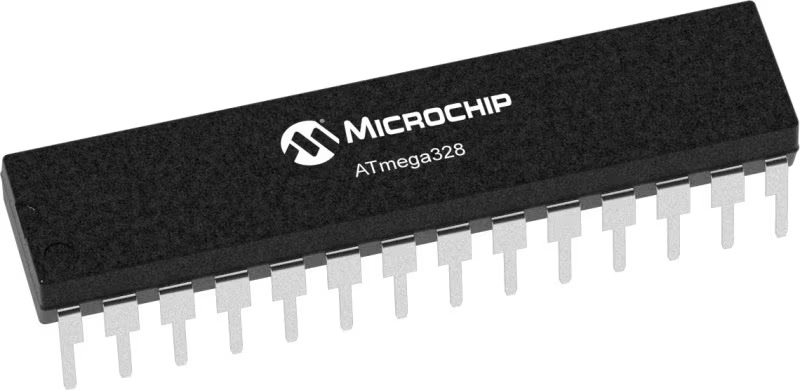
建筑
AVR
MCU 内存 (KB)
32
硅供应商
Microchip
引脚数
32
RAM (字节)
2048
你完善了我!
配件
Click Shield for Arduino UNO 具有两个专有的 mikroBUS™ 插座,使所有 Click board™ 设备能够轻松与 Arduino UNO 板进行接口连接。Arduino UNO 是一款基于 ATmega328P 的微控制器开发板,为用户提供了一种经济实惠且灵活的方式来测试新概念并构建基于 ATmega328P 微控制器的原型系统,结合了性能、功耗和功能的多种配置选择。Arduino UNO 具有 14 个数字输入/输出引脚(其中 6 个可用作 PWM 输出)、6 个模拟输入、16 MHz 陶瓷谐振器(CSTCE16M0V53-R0)、USB 接口、电源插座、ICSP 头和复位按钮。大多数 ATmega328P 微控制器的引脚都连接到开发板左右两侧的 IO 引脚,然后再连接到两个 mikroBUS™ 插座。这款 Click Shield 还配备了多个开关,可执行各种功能,例如选择 mikroBUS™ 插座上模拟信号的逻辑电平,以及选择 mikroBUS™ 插座本身的逻辑电压电平。此外,用户还可以通过现有的双向电平转换电压转换器使用任何 Click board™,无论 Click board™ 运行在 3.3V 还是 5V 逻辑电压电平。一旦将 Arduino UNO 板与 Click Shield for Arduino UNO 连接,用户即可访问数百种 Click board™,并兼容 3.3V 或 5V 逻辑电压电平的设备。
使用的MCU引脚
mikroBUS™映射器
“仔细看看!”
Click board™ 原理图

一步一步来
项目组装
软件支持
库描述
该库包含 BLE 10 Click 驱动程序的 API。
关键功能:
ble10_set_device_name- 这个函数设置本地设备名称。ble10_factory_reset- 这个函数将设备恢复出厂设置。ble10_get_temperature- 这个函数执行获取温度命令,返回模块内部温度传感器的当前温度。
开源
代码示例
完整的应用程序代码和一个现成的项目可以通过NECTO Studio包管理器直接安装到NECTO Studio。 应用程序代码也可以在MIKROE的GitHub账户中找到。
/*!
* @file main.c
* @brief BLE 10 Click Example.
*
* # Description
* This example reads and processes data from BLE 10 Clicks.
*
* The demo application is composed of two sections :
*
* ## Application Init
* Initializes the driver, then performs a factory reset and sets the local device name.
*
* ## Application Task
* Logs all the received events/responses on the USB UART.
* Then checks if there's a specific command string (defined by the GET_TEMP_COMMAND macro)
* received from the GATT Server, and if so, it executes temperature reading command and logs the results.
*
* ## Additional Function
* - static void ble10_clear_app_buf ( void )
* - static err_t ble10_process ( void )
* - static err_t bluetooth2_display_rsp ( char *rsp_end )
*
* @note
* We have used the nRF Connect smartphone application for the test.
* Make sure to configure the GATT Server properly in the nRF Connect application, then you
* will be able to send a desired command from it, once you connect to the Click board.
* You can use the Sample configuration for GATT Server which comes with the application installation
* and then send a command via Test Service from the Server.
*
* @author Stefan Filipovic
*
*/
#include "board.h"
#include "log.h"
#include "ble10.h"
#include "conversions.h"
#include "generic_pointer.h"
#define PROCESS_BUFFER_SIZE 200
// Response and Events macros.
#define RSP_TIMEOUT 20000
#define RSP_OK "OK"
#define RSP_ERROR "ERROR"
#define EVT_DONE "DONE"
#define EVT_RESET "RESET"
#define EVT_GATT_VAL "GATT_VAL"
// Local device name.
#define DEVICE_NAME "BLE 10 Click"
// The command string that will execute temperature reading, which is expected to be received
// from the GATT Server of the connected device.
#define GET_TEMP_COMMAND "get temp"
static ble10_t ble10;
static log_t logger;
static char app_buf[ PROCESS_BUFFER_SIZE ] = { 0 };
static int32_t app_buf_len = 0;
static int32_t app_buf_cnt = 0;
static uint8_t connection_flag = 0;
static uint16_t send_cnt = 0;
/**
* @brief BLE 10 clearing application buffer.
* @details This function clears memory of application buffer and reset it's length and counter.
* @note None.
*/
static void ble10_clear_app_buf ( void );
/**
* @brief BLE 10 data reading function.
* @details This function reads data from device and concatenates data to application buffer.
*
* @return @li @c 0 - Read some data.
* @li @c -1 - Nothing is read.
* @li @c -2 - Application buffer overflow.
*
* See #err_t definition for detailed explanation.
* @note None.
*/
static err_t ble10_process ( void );
/**
* @brief BLE 10 display response function.
* @details This function reads data from device until sends @a rsp_end or ERROR message or until
* it exceeds the timeout value.
* @param[in] rsp_end : Response/Event ending string [OK, DONE, RESET, GATT_VAL].
*
* @return @li @c 0 - Read some data.
* @li @c -1 - Nothing is read.
*
* See #err_t definition for detailed explanation.
* @note None.
*/
static err_t ble10_display_rsp ( char *rsp_end );
void application_init ( void )
{
log_cfg_t log_cfg; /**< Logger config object. */
ble10_cfg_t ble10_cfg; /**< Click config object. */
/**
* Logger initialization.
* Default baud rate: 115200
* Default log level: LOG_LEVEL_DEBUG
* @note If USB_UART_RX and USB_UART_TX
* are defined as HAL_PIN_NC, you will
* need to define them manually for log to work.
* See @b LOG_MAP_USB_UART macro definition for detailed explanation.
*/
LOG_MAP_USB_UART( log_cfg );
log_init( &logger, &log_cfg );
log_info( &logger, " Application Init " );
// Click initialization.
ble10_cfg_setup( &ble10_cfg );
BLE10_MAP_MIKROBUS( ble10_cfg, MIKROBUS_1 );
err_t init_flag = ble10_init( &ble10, &ble10_cfg );
if ( UART_ERROR == init_flag )
{
log_error( &logger, " Application Init Error. " );
log_info( &logger, " Please, run program again... " );
for ( ; ; );
}
ble10_default_cfg ( &ble10 );
ble10_process( );
ble10_clear_app_buf( );
app_buf_len = 0;
app_buf_cnt = 0;
log_printf( &logger, " - Factory Reset -\r\n" );
ble10_factory_reset ( &ble10 );
ble10_display_rsp ( EVT_RESET );
log_printf( &logger, " - Set Device Name -\r\n" );
ble10_set_device_name ( &ble10, DEVICE_NAME );
ble10_display_rsp ( RSP_OK );
log_info( &logger, " Application Task " );
}
void application_task ( void )
{
ble10_process( );
if ( app_buf_len > 0 )
{
Delay_ms ( 100 );
ble10_process( );
for ( int32_t buf_cnt = 0; buf_cnt < app_buf_len; buf_cnt++ )
{
log_printf( &logger, "%c", app_buf[ buf_cnt ] );
}
if ( strstr( app_buf, EVT_GATT_VAL ) )
{
char get_temp_cmd[ ] = GET_TEMP_COMMAND;
const char * __generic_ptr msg_ptr = strrchr ( app_buf, ',' ) + 1;
uint8_t msg_len = *( msg_ptr - 2 ) - 48;
if ( msg_len == strlen ( get_temp_cmd ) )
{
char get_temp_hex[ 64 ] = { 0 };
uint8_t get_temp_hex_chr[ 3 ] = { 0 };
uint8_t cnt = 0;
for ( cnt = 0; cnt < strlen ( get_temp_cmd ); cnt++ )
{
uint8_to_hex ( get_temp_cmd[ cnt ], get_temp_hex_chr );
strcat ( get_temp_hex, get_temp_hex_chr );
}
if ( 0 == memcmp ( get_temp_hex, msg_ptr, strlen ( get_temp_hex ) ) )
{
ble10_clear_app_buf( );
log_printf( &logger, " - Get Temperature -\r\n" );
ble10_get_temperature ( &ble10 );
ble10_display_rsp ( RSP_OK );
}
}
}
ble10_clear_app_buf( );
}
Delay_ms ( 1 );
}
int main ( void )
{
/* Do not remove this line or clock might not be set correctly. */
#ifdef PREINIT_SUPPORTED
preinit();
#endif
application_init( );
for ( ; ; )
{
application_task( );
}
return 0;
}
static void ble10_clear_app_buf ( void )
{
memset( app_buf, 0, app_buf_len );
app_buf_len = 0;
app_buf_cnt = 0;
}
static err_t ble10_process ( void )
{
int32_t rx_size;
char rx_buff[ PROCESS_BUFFER_SIZE ] = { 0 };
rx_size = ble10_generic_read( &ble10, rx_buff, PROCESS_BUFFER_SIZE );
if ( rx_size > 0 )
{
int32_t buf_cnt = 0;
if ( app_buf_len + rx_size >= PROCESS_BUFFER_SIZE )
{
ble10_clear_app_buf( );
return BLE10_ERROR;
}
else
{
buf_cnt = app_buf_len;
app_buf_len += rx_size;
}
for ( int32_t rx_cnt = 0; rx_cnt < rx_size; rx_cnt++ )
{
if ( rx_buff[ rx_cnt ] != 0 )
{
app_buf[ ( buf_cnt + rx_cnt ) ] = rx_buff[ rx_cnt ];
}
else
{
app_buf_len--;
buf_cnt--;
}
}
return BLE10_OK;
}
return BLE10_ERROR;
}
static err_t ble10_display_rsp ( char *rsp_end )
{
uint32_t timeout = RSP_TIMEOUT;
while ( timeout-- )
{
ble10_process( );
if ( app_buf_len > 0 )
{
for ( int32_t buf_cnt = 0; buf_cnt < app_buf_len; buf_cnt++ )
{
log_printf( &logger, "%c", app_buf[ buf_cnt ] );
}
if ( strstr( app_buf, rsp_end ) )
{
ble10_clear_app_buf( );
Delay_ms ( 100 );
ble10_process( );
for ( int32_t buf_cnt = 0; buf_cnt < app_buf_len; buf_cnt++ )
{
log_printf( &logger, "%c", app_buf[ buf_cnt ] );
}
ble10_clear_app_buf( );
log_printf( &logger, "--------------------------------\r\n" );
return BLE10_OK;
}
ble10_clear_app_buf( );
}
Delay_ms ( 1 );
}
return BLE10_ERROR;
}
// ------------------------------------------------------------------------ END
额外支持
资源
类别:蓝牙/蓝牙低功耗
